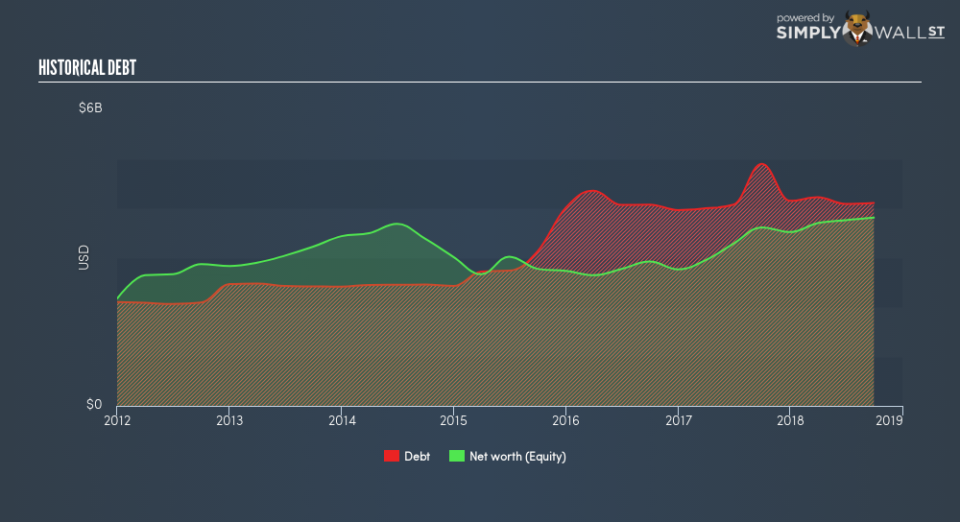What Investors Should Know About Aptiv PLC’s (NYSE:APTV) Financial Strength

There are a number of reasons that attract investors towards large-cap companies such as Aptiv PLC (NYSE:APTV), with a market cap of US$17b. Doing business globally, large caps tend to have diversified revenue streams and attractive capital returns, making them desirable investments for risk-averse portfolios. However, the key to extending previous success is in the health of the company’s financials. Today we will look at Aptiv’s financial liquidity and debt levels, which are strong indicators for whether the company can weather economic downturns or fund strategic acquisitions for future growth. Note that this commentary is very high-level and solely focused on financial health, so I suggest you dig deeper yourself into APTV here.
View our latest analysis for Aptiv
How much cash does APTV generate through its operations?
APTV’s debt levels have fallen from US$4.9b to US$4.1b over the last 12 months , which also accounts for long term debt. With this reduction in debt, the current cash and short-term investment levels stands at US$771m for investing into the business. On top of this, APTV has generated cash from operations of US$1.3b over the same time period, leading to an operating cash to total debt ratio of 32%, indicating that APTV’s operating cash is sufficient to cover its debt. This ratio can also be a sign of operational efficiency as an alternative to return on assets. In APTV’s case, it is able to generate 0.32x cash from its debt capital.
Can APTV meet its short-term obligations with the cash in hand?
With current liabilities at US$3.4b, it seems that the business has been able to meet these commitments with a current assets level of US$5.2b, leading to a 1.54x current account ratio. For Auto Components companies, this ratio is within a sensible range since there’s a sufficient cash cushion without leaving too much capital idle or in low-earning investments.
Can APTV service its debt comfortably?
Considering Aptiv’s total debt outweighs its equity, the company is deemed highly levered. This isn’t surprising for large-caps, as equity can often be more expensive to issue than debt, plus interest payments are tax deductible. Since large-caps are seen as safer than their smaller constituents, they tend to enjoy lower cost of capital. We can test if APTV’s debt levels are sustainable by measuring interest payments against earnings of a company. Net interest should be covered by earnings before interest and tax (EBIT) by at least three times to be safe. For APTV, the ratio of 13.69x suggests that interest is comfortably covered. High interest coverage is seen as a responsible and safe practice, which highlights why most investors believe large-caps such as APTV is a safe investment.
Next Steps:
APTV’s high cash coverage means that, although its debt levels are high, the company is able to utilise its borrowings efficiently in order to generate cash flow. This may mean this is an optimal capital structure for the business, given that it is also meeting its short-term commitment. Keep in mind I haven’t considered other factors such as how APTV has been performing in the past. You should continue to research Aptiv to get a more holistic view of the large-cap by looking at:
Future Outlook: What are well-informed industry analysts predicting for APTV’s future growth? Take a look at our free research report of analyst consensus for APTV’s outlook.
Valuation: What is APTV worth today? Is the stock undervalued, even when its growth outlook is factored into its intrinsic value? The intrinsic value infographic in our free research report helps visualize whether APTV is currently mispriced by the market.
Other High-Performing Stocks: Are there other stocks that provide better prospects with proven track records? Explore our free list of these great stocks here.
To help readers see past the short term volatility of the financial market, we aim to bring you a long-term focused research analysis purely driven by fundamental data. Note that our analysis does not factor in the latest price-sensitive company announcements.
The author is an independent contributor and at the time of publication had no position in the stocks mentioned. For errors that warrant correction please contact the editor at editorial-team@simplywallst.com.

